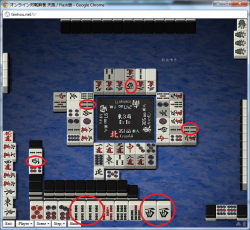Tenpai
Tenpai 「テンパイ」 is also referred to as the "ready hand". A hand is tenpai or "ready" when only one more tile is needed to complete the hand. The completion may be either done by draw and/or discard, where applicable. Tenpai does not require that the completed hand has a yaku, although both a completed hand and a yaku are necessary to win. Having achieving tenpai is worth some points when a hand ends in ryuukyoku.
The direct opposite of tenpai noten 「ノテン」. This word is a contraction of the English no tenpai. A hand in this state absolutely has no chance of winning upon the immediate draw or discard. Instead, it relies on further tile draws and discards to attain the state of tenpai.
Overall, the recognition of a tenpai hand is one of the most important concepts of the game. Without this recognition, then a player lacks the ability to make the best decisions on which tiles to best discard.
Example tenpai hands
For both of these examples, riichi may be called, and/or a player can simply win by self draw. The first two possess yaku. However, the third example does not, as it stands. It requires riichi, mentsumo, or even the likes of haitei, houtei, rinshan, or chankan to gain yaku. Regardless, all three are closed tenpai hands.
- This example uses hadaka tanki.
Tenpai conditions
Tenpai occurs under any of the four following conditions:
- Three tile groups and a pair (jantou). The fourth tile group needs completion. Numerous patterns fall under this condition.
- Four tile groups and a single tile (tanki). Completion occurs when a duplicate of the pair is drawn or discarded.
- Chiitoitsu. Six distinct tile pairs and a single tile (also tanki).
- Kokushi musou.
Jantou
Wait patterns
Every hand in tenpai involves some sort of wait pattern, or machi 「待ち」. Various wait patterns are conveniently named, because of their frequency. Some occur more than others. Overall, associating the different patterns with names helps with the ability to quickly recognize them and their waiting tiles. Likewise, players who recognize these patterns may also be able to select among them.
Karaten

Karaten 「カラテン」, or empty tenpai, is a state where a tenpai hand does not have the ability to win. This is due to unavailability of all instances of winning tiles. The "visible tiles" may either be discarded, used as a dora indicator, or already exist in one's hand. Furthermore, they may be held in other player's hands or even reside within the dead wall. Though, the latter case is beyond a player's visibility.
Under some rule variations, a karaten tenpai hand may be considered as noten under the following circumstances:
- All hand-completing tiles are already used within the player's own hand. Declared kans and open melds belong to the hand. If a player has a 1-2 penchan and a previously declared kan of 3-3-3-3 in the same suit, no more threes are available as winning tiles.
- All hand-completing tiles are visible among declared kans, open melds, discards, and dora indicators. Only some rules have such a large scope for karaten.
Dead hand
A dead hand involves a minor penalty, but not subject to chombo. Dead hands often involve minor mistakes, such as a certain number of accidental bumps to the wall or a mistake regarding open calls. A player with a dead hand is never considered tenpai, even if the tiles in the hand show a state of tenpai.
Tenpai with no yaku
The definition of tenpai does not necessarily apply to yaku.
This is a common pitfall for many beginners. Hands are built to tenpai. However, due to lack of or limited knowledge of the yaku, players may find themselves unable to declare a win. Often, the hand simply lacks yaku. Otherwise, furiten may also be a reason. In this state, it is still possible to produce yaku via haitei, houtei, and even possibly rinshan. This is particularly true of open hands. For closed hands, tsumo may count as an additional option.
Ryuukyoku
At the end of the hand where all tiles have been drawn other than those in the dead wall, points are rewarded to tenpai hands.
External links
- Tenpai in Japanese Wikipedia